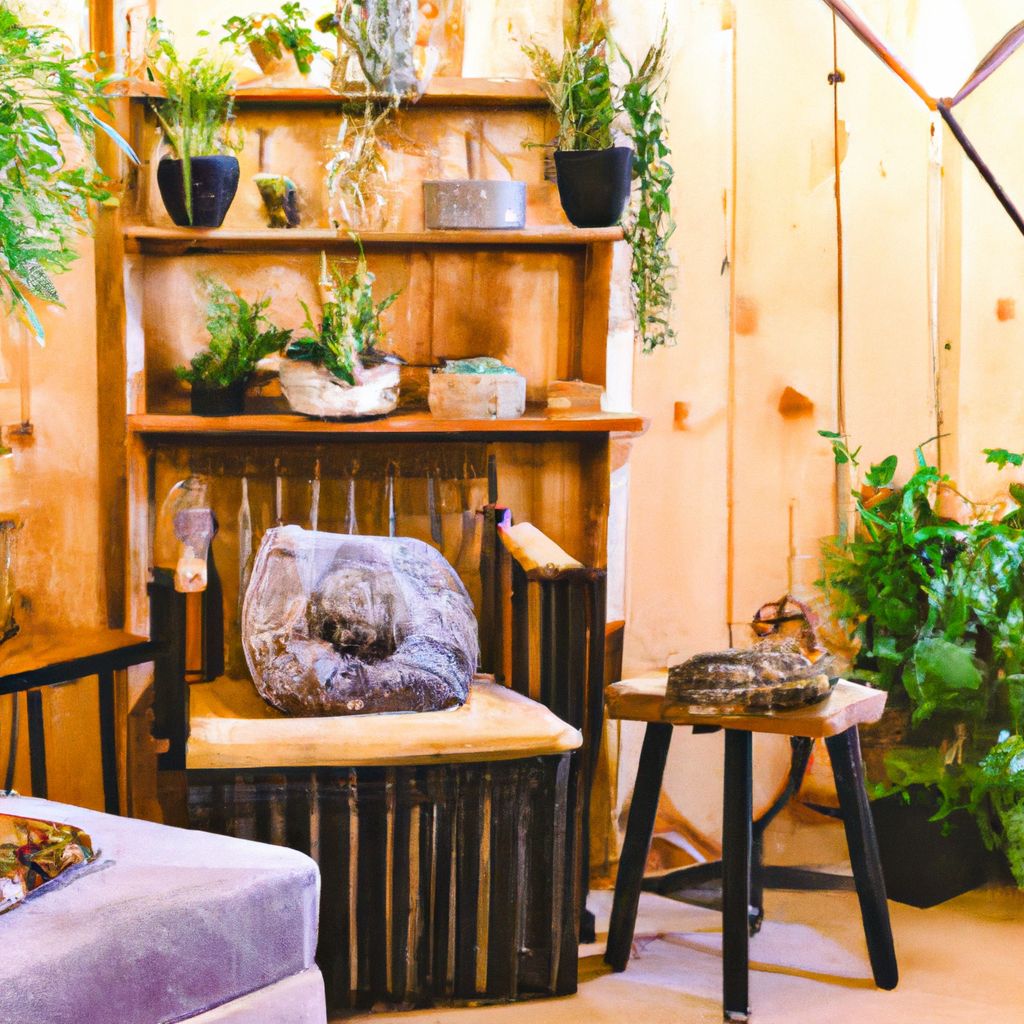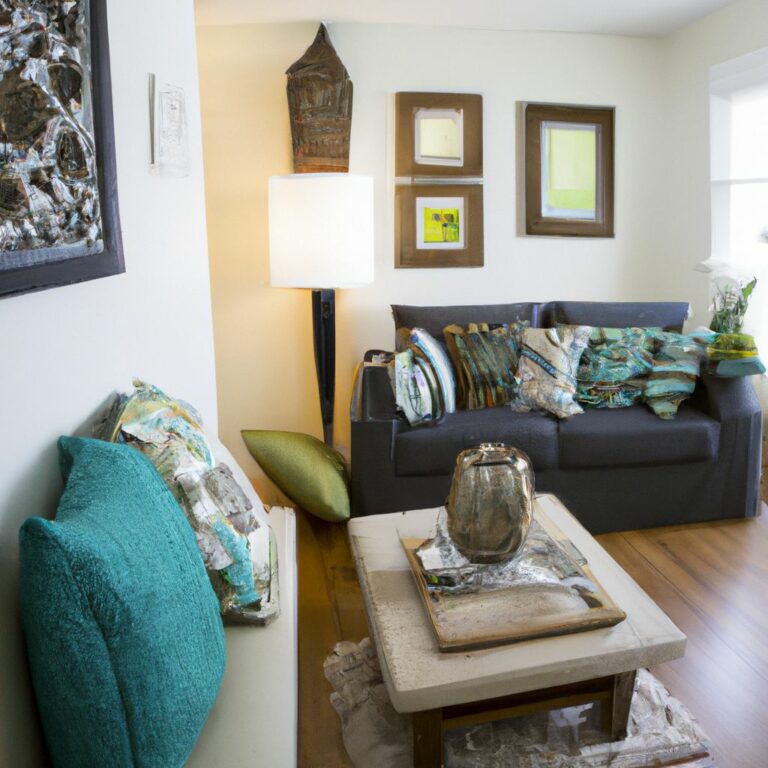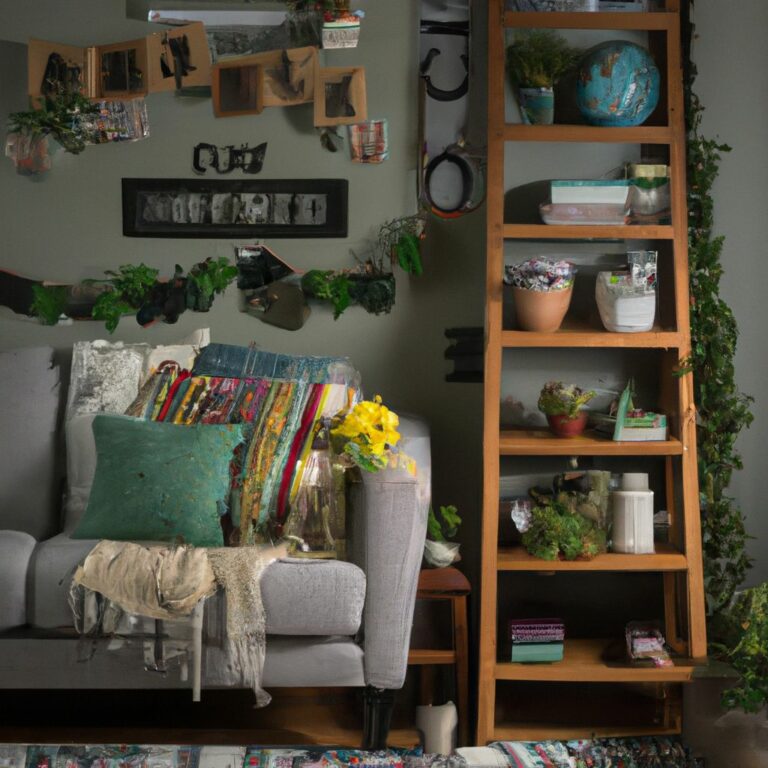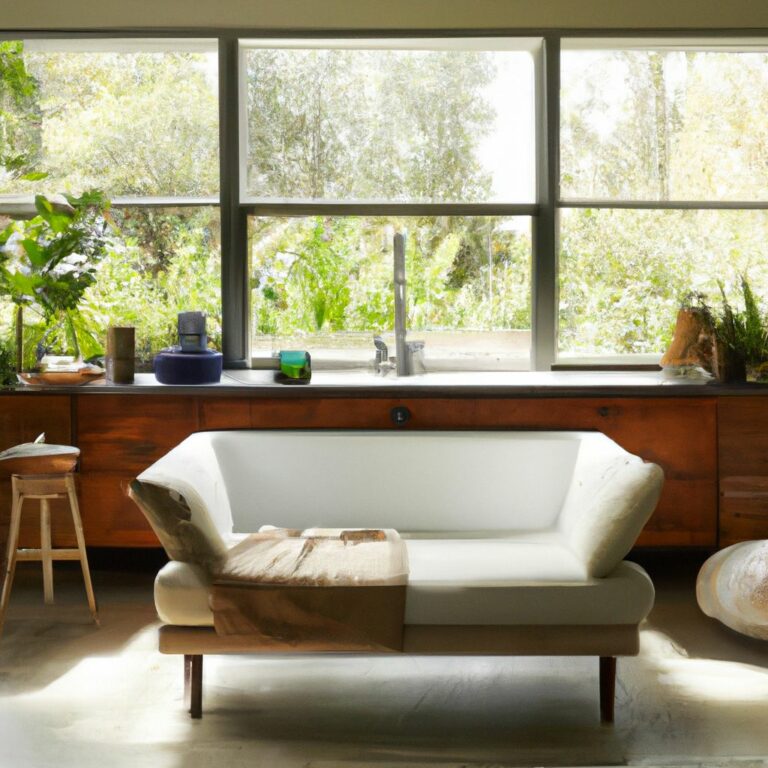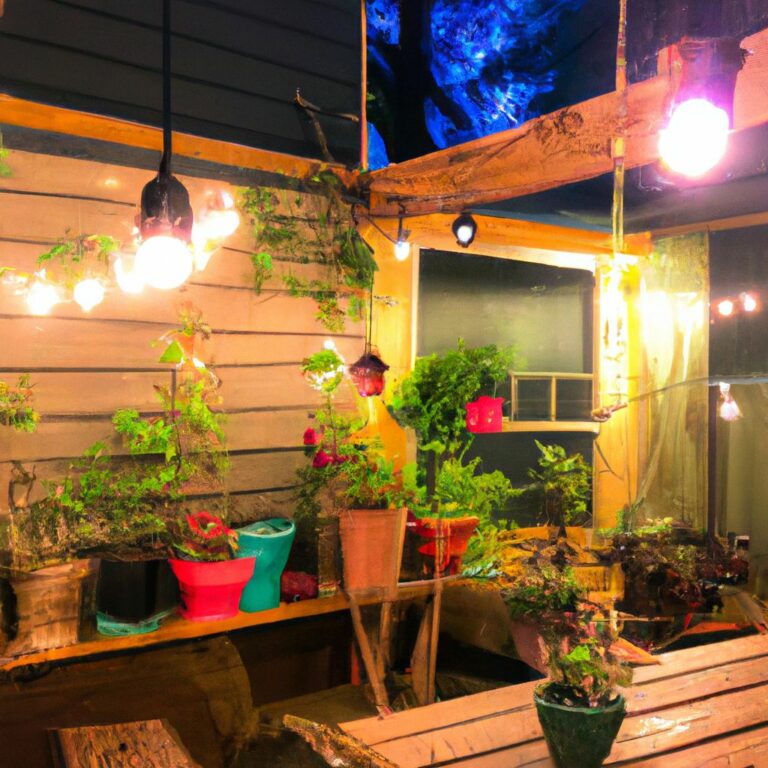Introduction: The Importance of Sustainable Home Decor
Creating a sustainable home decor isn’t just about looks. It’s about making good choices that help the environment and our health. We can make our space beautiful and eco-friendly.
Lowering waste is one way to go green. Choose long-lasting materials such as reclaimed wood or bamboo. Not only do they look unique, but they also reduce demand for new resources.
Think about energy efficiency too. Invest in LED lights, smart home tech, and energy-efficient appliances. They use less energy and last longer.
Add natural elements like houseplants. Not only are they gorgeous, but they reduce toxins in the air too. Opt for organic textiles and materials from renewable sources like cotton or hemp.
When shopping, look for certifications like FSC (Forest Stewardship Council). That way, you know the product is sourced responsibly.
By making conscious choices, we have the power to make a positive impact on the environment and decorate our home with beautiful sustainable pieces. Say no to plastic plants and silk worms – go green instead!
Sustainable Materials for Home Decor
Sustainable materials play a crucial role in home decor as they promote an eco-friendly and socially responsible approach to interior design. By incorporating sustainable materials, such as reclaimed wood, bamboo, recycled glass, and organic textiles, homeowners can create a stylish and environmentally conscious living space. These materials offer unique aesthetic qualities while reducing the carbon footprint and minimizing waste. Their use can contribute to a healthier, more sustainable planet.
Reclaimed wood: making your home stylish and the trees grateful for a second chance at life.
Reclaimed Wood: A Stylish and Eco-Friendly Option
Reclaimed wood is a stylish, eco-friendly choice for home decor. Its uniqueness and sustainability make it a popular pick for homeowners looking for sustainable materials. Here are three reasons why it’s an excellent pick:
- Sustainability: Reclaimed wood comes from old buildings, barns, or factories, giving it a second life and reducing the demand for newly harvested timber. Choosing this helps preserve natural resources and limit deforestation.
- Unique Look: Each piece of reclaimed wood has its own history, character, and weathered appearance. The aged textures and natural patina give any space warmth and charm, in a way that can’t be replicated with new materials.
- Durability: Reclaimed wood has already proven its strength, making it extra durable. Its strength and stability mean it can withstand years of use without compromising integrity.
Besides these benefits, using reclaimed wood has other advantages like reducing landfill waste, supporting local craftsmen who specialize in reclaiming materials, and promoting sustainable construction practices.
If you’d like to incorporate reclaimed wood into your home decor, here are some suggestions:
- Furniture: Use reclaimed wood to make stunning furniture pieces like dining tables, coffee tables, or countertops. The unique grain patterns and imperfections will add character to your living spaces.
- Accent Walls: Put up reclaimed wood panels on a feature wall to create a fascinating focal point in any room. It’ll give your space a rustic yet modern touch, while adding texture and depth.
- Decorative Accents: Utilize small pieces of reclaimed wood to create decorative accents such as shelves, picture frames, or wall art. These pieces will not only look great, but also contribute to creating a more sustainable environment.
By incorporating reclaimed wood into your home decor, you can help the environment and create a unique, attractive living space. Its durability guarantees that your investment will last and make a positive impact on the planet.
Energy-Efficient Lighting Solutions
Energy-Efficient Lighting Solutions can significantly reduce energy consumption and provide long-lasting illumination. By incorporating smart lighting systems, such as LED bulbs and motion sensors, households can optimize energy usage and reduce electricity bills. Additionally, the use of natural light through skylights and strategically placed windows can further enhance energy efficiency.
A table can be used to display the various Energy-Efficient Lighting Solutions and their benefits. Here is an example:
| Lighting Solution | Benefits |
|---|---|
| LED Bulbs | Energy-saving, longer lifespan |
| Motion Sensors | Automatic on/off, energy conservation |
| Skylights | Natural lighting, reduced need for artificial light sources |
To delve into unique details, it is worth mentioning that LED bulbs not only consume less energy but also emit less heat, making them a safer choice. Motion sensors can detect movement and automatically switch off lights in unoccupied areas, preventing unnecessary energy consumption. Skylights allow for the entry of natural daylight, reducing reliance on artificial lighting during the day.
In illustrating the benefits of energy-efficient lighting, a true story comes to mind. A family decided to replace all their conventional bulbs with LED bulbs. They were amazed to discover a significant decrease in their electricity bills. Not only did they benefit financially, but they also contributed to a more sustainable environment by reducing their carbon footprint.
By adopting Energy-Efficient Lighting Solutions, individuals can achieve a balance between functionality, aesthetics, and sustainability in their homes. LED lighting: illuminating your home and the future of sustainable design, because who needs a relationship when you can have a long-lasting, energy-saving bulb?
LED Lighting: Brightening Your Home While Saving Energy
LED lighting is an energy-efficient way to light up your home while reducing energy use. Its long life and low power consumption make it a popular choice for homeowners. Here’s what you need to consider:
- Energy savings: LED lights use less energy than traditional incandescent bulbs, resulting in lower electricity bills.
- Longevity: LED lights last 25 times longer than incandescent bulbs.
- Environmentally friendly: LEDs don’t have hazardous substances like mercury.
- Brightness control: LEDs allow you to adjust the brightness to your needs.
- Instant illumination: LEDs light up fast – no warm-up time.
- Versatility: LEDs come in many shapes and sizes, fitting any design.
On top of that, LEDs produce less heat than regular bulbs. So they’re safer around children and pets.
LED lighting started as a concept back in 1962. It took a while for progress to be made. In the late 1990s, high-brightness LEDs changed the industry. Since then, many innovations have led to LED lighting being widely used in homes.
Indoor Plants: Bringing Nature into Your Home
Indoor Greenery: Embracing the Serenity of Nature in Your Living Space
Indoor plants not only add aesthetic appeal to your home but also offer numerous benefits. They purify the air, increase humidity, and reduce stress levels. Here are six reasons why bringing indoor plants into your home is a great idea:
- Enhanced air quality: Indoor plants act as natural air purifiers, removing toxins and releasing fresh oxygen.
- Improved well-being: The presence of greenery indoors has a calming effect, reducing stress and promoting relaxation.
- Enhanced focus and productivity: Studies have shown that having indoor plants in workspaces enhances concentration and productivity.
- Natural humidity regulation: Plants release moisture through a process called transpiration, balancing the humidity in your home.
- Improved sleep quality: Certain plants, such as lavender and jasmine, emit scents that promote better sleep and relaxation.
- Elevated interior aesthetics: Indoor plants bring a sense of beauty and freshness to any living space, enhancing the overall decor.
In addition to these benefits, maintaining indoor plants requires minimal effort. Regular watering and proper placement according to light requirements are the key factors for their well-being.
Now, let’s delve into a unique detail: indoor plants, specifically succulents, require less maintenance compared to other varieties due to their ability to store water, making them ideal for busy individuals.
To illustrate the impact of indoor plants, I recall the story of my friend, Jessica. She was feeling constantly stressed and overwhelmed by the demands of her job. Upon introducing a few indoor plants into her apartment, she noticed a remarkable change in her mood and overall well-being. The greenery brought a sense of tranquility and relaxation, making her living space feel like a peaceful oasis.
Indoor plants: the only green you can’t kill, unless you forget to water them for three months straight.
Benefits of Indoor Plants for Sustainable Home Decor
Indoor plants bring unique beauty and charm to any space. Plus, they offer numerous advantages for sustainable home decor – from improved air quality to increased productivity and natural stress relief! Not to mention, they require minimal water and energy, making them an eco-friendly choice.
So why wait? Embrace the natural beauty of indoor plants and create an inviting atmosphere in your home. Explore the wide range of options available today and experience their transformative power.
Go green with sustainable furniture choices – nothing says ‘saving the planet’ like sitting on a couch made from recycled plastic bottles! Just make sure you don’t spill your coffee, it might start leaking.
Eco-Friendly Furniture Choices
Consumers now care more for their environmental impact, so eco-friendly furniture is gaining popularity. It not only helps with sustainable living, but adds a unique touch to home decor.
Using natural and renewable materials, like bamboo, reclaimed wood, or cork, is one way to go green with your furniture. Less virgin resources are used, and production has minimal carbon footprint.
You can also opt for furniture made from recycled or upcycled materials. Repurposing discarded items, such as old doors or pallets, gives them new life and reduces landfill waste.
Look for certifications like FSC or C2C when buying furniture. These ensure the materials are ethically sourced and recyclable.
Furniture with non-toxic finishes and treatments is healthier for you and your family. Natural finishes, like plant-based oils and water-based paints, are better than conventional options that off-gas and pollute the air.
These eco-friendly furniture choices not only improve your home’s looks, but help the planet too. Adopt sustainability as your design principle and make a positive impact.
Upcycling and Repurposing: Giving New Life to Old Items
Upcycling and Repurposing can give new life to old items – a creative and eco-friendly way to decorate. It not only adds unique charm, but also reduces waste and promotes environmental consciousness.
- Take furniture and make stylish statement pieces. Instantly elevate any space.
- Glass jars, wine bottles, and tin cans can be repurposed as planters or storage containers, adding a personal touch while reducing landfill waste.
- Vintage fabric or old clothing can be upcycled into pillow covers, curtains, or tablecloths – giving them a new purpose and a nostalgic vibe.
Furthermore, upcycling and repurposing offer endless possibilities for customizing and being creative. With imagination and DIY skills, ordinary items can become extraordinary works of art! Antique doors can be turned into headboards, and old wooden crates into functional shelves. Upcycling allows you to show off your individual style while helping the environment.
One great example is Jane, a DIY enthusiast. She transformed an old wooden ladder in her garage into an amazing bookshelf with shelves at different heights. It gave her affordable storage for her book collection, and rustic charm to her living room. Jane’s approach shows how upcycling can breathe new life into forgotten items and bring personality to decor.
Make your home decor more sustainable? Opt for organic and natural fabrics – because nothing says eco-friendly like a chair that’s dressed to impress…with Mother Earth!
Sustainable Textiles: Choosing Organic and Natural Fabrics
Choosing organic and natural fabrics is a wise choice for sustainable textiles. These fabrics are not only good for the environment, but also safe for our health. By opting for organic cotton, linen, hemp, or bamboo, we can reduce our negative impact on the planet.
Organic fabrics are produced with methods that minimize the use of pesticides and fertilizers. This helps protect ecosystems and biodiversity. Additionally, it consumes less water than conventional cotton farming.
Natural dyes are made from plants and other natural sources. This reduces chemical waste and pollution. Plus, it creates a unique color palette not achievable with synthetic dyes.
Bamboo fabric is a great sustainable choice. It grows quickly and requires minimal water. It’s hypoallergenic and has antibacterial properties. By choosing bamboo, we support sustainable agricultural practices.
We can use these sustainable textiles for curtains, upholstery, bedding, or even clothing accessories. Not only will they add a touch of eco-friendliness to our homes, but also help create a healthier environment overall. Who needs toxic fumes when you can have low VOC paints and finishes to make your home as clean as your conscience?
Low VOC Paints and Finishes: Creating a Healthy Living Environment
Text:
Low VOC paints and finishes are key for a healthy living space. They have fewer volatile organic compounds, which lowers indoor air pollution. Choosing low VOC is a great way to protect your family’s health.
Using low VOC paints and finishes is a simple way to have a healthy home. Traditional paint releases fumes that can cause respiratory issues and allergies. Low VOC products reduce this risk with fewer toxic chemicals.
Not only do low VOC paints and finishes help your health, they benefit the environment too. They have lower levels of solvents and hazardous substances, meaning less emissions while manufacturing and disposing. So, they are an eco-friendly choice for home decor.
Sarah switched to low VOC paint after experiencing headaches and nausea when she painted with traditional paint. Once she changed, she felt much better. Her experience highlights the importance of healthier alternatives for our homes.
By choosing low VOC paints and finishes you protect your well-being and the planet. Embrace this eco-friendly approach and give your home a sustainable makeover – it’s time to show off your style and help Mother Nature shine!
Conclusion: Creating a Beautiful and Sustainable Home Space
Creating a beautiful and eco-friendly home requires careful decisions. We can mix style, usefulness, and sustainability to create a living space that’s healthy for us and the environment.
Select sustainable materials for furniture and decorations. Opt for furniture made from recycled or reclaimed wood to reduce deforestation and add character. Plus, use organic cotton or bamboo for curtains and upholstery, as they are biodegradable and use less water.
Decrease energy usage by buying energy-efficient appliances and LED light bulbs. Let the natural sunlight in by having bigger windows. You can even install solar panels for renewable energy sources.
Bring nature into your home with indoor plants that improve air quality and livens up the place. Additionally, use sustainable flooring options like bamboo or cork which are renewable resources with low environmental impact.
To make your home decor more sustainable, repurpose old items instead of buying new. Refinish or reupholster old furniture with eco-friendly materials. Upcycle glass jars for stylish vases or containers.
- Easy DIY home decoration projects - June 25, 2023
- Upcycled items for home decor - June 25, 2023
- Vintage home decor ideas - June 25, 2023
